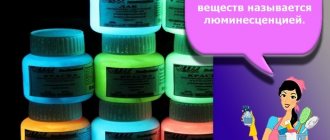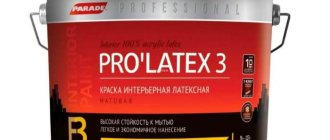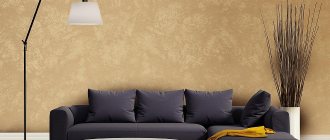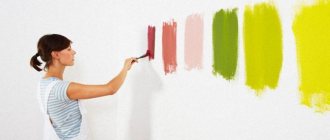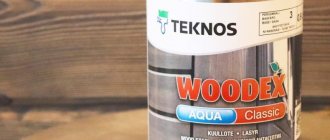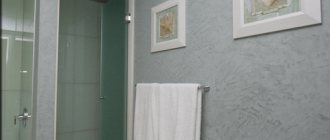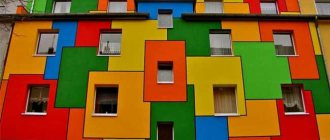Glitter wall paint adds an element of luxury to the interior. Its structure contains a small amount of flickering particles sealed in insoluble shells.
Paint coatings with glitter dry quickly and are resistant to fading and chemicals. With their help, you can imitate almost any surface, while emphasizing the exclusivity of the environment.
On the left is paint with glitter applied to wallpaper, on the right is paint with a glitter effect on plaster.
Options for using glitter paints in the interior
Paints with glitter in their composition are of the decorative type. Such paints and varnishes are used mainly for painting interior walls. Using paint with a shimmering effect, you can decorate a small or, conversely, large room.
Glitter compositions are used in the following cases:
- in shopping malls - for exclusive decoration of walls, columns, arches, cornices;
- in nightclubs, bars, restaurants - for room decoration;
- in living rooms - to decorate a wall near which there is no furniture;
- in the kitchen - in the finishing of the apron;
- in a nursery - as an accent on a free wall or ceiling;
- in the hallway - to decorate the ceiling or wall free from furniture;
- in the bathroom - to decorate the ceiling or wall;
- for decorating furniture built into the wall (in combination with furniture varnish);
- glitter can be added to the grout for tile joints.
Paintwork materials with glitter can be used for continuous coloring or for drawing patterns (vegetal, futuristic). Glitter paints are made based on popular compositions (acrylic, alkyd, polyurethane). The main difference between paintwork materials with glitter and regular ones is the presence of sparkles in the mixture. These are the smallest particles of a metallized shiny film, which is made of aluminum or polyethylene terephthalate. Sequins come in sizes of 0.1-0.4 mm.
Glitter is available in silver, bronze, gold, iridescent purple, blue, and green. The glitter is cut using special equipment and can be in the shape of stars, circles, hexagons, and squares.
See also
Pros and cons of popular kitchen paints and which one is better to choose
Types of glitter that are used in construction paints:
- colored (golden, silver, red);
- holographic (with 3D effect);
- rainbow (pearl);
- fluorescent (glowing in UV radiation).
Paintwork materials with glitter come in different colors and are used for painting walls or creating patterns on them. There are glitter varnishes that are applied over a painted surface. Compositions with glitter can be used on non-woven wallpaper.
In addition to ready-to-use glitter paints, hardware stores sell dry glitter in bags or liquid glitter in jars, in the form of a gel-like substance. Glitter is added to acrylic, alkyd, oil, and polyurethane paints before painting. Paintwork materials with glitter can be applied to concrete, wood, plaster, and plasterboard.
How to choose decorative paint or varnish?
Transparent varnishes are available that will refresh the surface, paint in any shade, multi-colored shiny coatings, with the effect of brocade, pearls or metal. What kind of interiors do they work in?
The wall paint market is incredibly diverse, and provides the opportunity to realize even the most inventive ideas. Decorative paint with glitter, acrylic or water-based, in the form of a gel or even a spray, adds a glamorous accent to the interior. Small particles strongly scatter light and illuminate the room, making it visually more spacious.
- Varnish. One possibility is to use a silk effect clear varnish that is applied to a previously painted wall in the color of your choice. Thanks to this, every surface will glow without changing the original color. The main purpose of varnish is to protect the walls so that they can be cleaned. In addition, it serves to achieve appropriate decorative effects. These varnishes can be used on the following wall coverings:
- all types of satin and latex paints;
- structural plasters;
- stucco;
- Venetian plaster;
- travertine;
- textured coatings;
- liquid wallpaper;
- many other interior items.
- Another option is to choose decorative paint with a specific color. This is the perfect way to change up your interior or freshen up your walls. The color palette is very wide, and each manufacturer offers interesting shades that match many finishing styles.
Wall paint with glitter, photo
Having chosen such a product, we need to think about what effect we want to achieve. The range includes both traditional, pearl and metallic effects in different shades.
Advice:
- silver harmonizes perfectly with cool tones;
- gold and fashionable copper - with warm colors.
You can experiment with combinations of different layers of paint. For example, textured paint will give the wall a rough surface, while covering it with emulsion paint with a gloss will cause the sun's rays to refract on its surface. This creates a very pleasing result and can be a great suggestion when decorating a child's room, where such "glitter" will certainly be well received.
Advantages and disadvantages
Advantages and disadvantages
creates a unique shiny coating;
can be used for solid painting and drawing patterns;
coating with glitter visually enlarges and expands the room (recommended for small and narrow rooms);
glitter makes the room light, spacious, and elegant;
The shiny coating is resistant to moisture, ultraviolet radiation, and soap;
glitter is not corroded by solvents and mixes well with any dispersions, enamels and varnishes;
The shiny coating has a long service life.
glitter compositions have a relatively high cost;
glitter often falls off.
Shiny surface combined with texture
Painting walls with the addition of glitter is popular when decorating smooth and embossed surfaces. An interesting effect can be achieved on walls covered with decorative plaster. Shiny particles penetrate into the unevenness of the decorative layer and refract the light many times. This makes the accent wall look unique.
Mosaic painting with the addition of glitter allows you to imitate marble, granite, sand and other surfaces. Using paints that can absorb daylight and come to life under a fluorescent lamp, it’s easy to achieve a fantasy effect.
Criteria for choosing shiny paint
Paintwork materials with a shimmering effect are mainly used for decorative purposes. In hardware stores you can buy fully prepared paints with glitter in the composition. Typically, the words “pearl”, “decorative pearl”, “diamond”, “glitter”, “fluorescent” are written on the label of such paints and varnishes. There are even ready-made glitter paints available in spray form.
Expert opinion
Zakharova Irina Yurievna
Cleaning professional with 15 years of experience. Our best expert.
Ask a Question
If desired, you can make your own shiny dye. In this case, you need to buy glitter (in bags) or glitter gel. These additives are added to paint materials based on water, drying oil or synthetic solvents.
Paints and varnishes to which glitter can be added:
- acrylic dispersions;
- acrylic water-based compositions;
- latex, alkyd, polyurethane enamels;
- oil paints;
- varnishes (acrylic, polyurethane, alkyd).
See also
Features of silicone paints and consumption, how to apply and do it yourself
The choice of paint and varnish materials for repair is influenced by the painting method, type of surface and performance characteristics. If you need to draw a pattern on a wall painted with acrylic, then buy acrylic glitters in small tubes. If you want to give a shimmering effect to a large wall surface, then choose glitter in bags.
In dry rooms, water dispersions or acrylic-based water emulsions are used. In rooms with high humidity, rubber, alkyd, and polyurethane compounds are used.
You can add glitter to a clear varnish and polish a painted wall. Shiny paintwork materials can be used on top of decorative plaster and non-woven wallpaper. Glitter varnish can be used to varnish stucco moldings, patterns, and individual sections of the wall.
Glitter and cosmetics. How to create your own nail polish and rub, eye shadow and lipstick?!
Every year there are more and more brands of good quality cosmetics produced by ordinary people or small companies. This is due to the fact that the manufacturing process itself is not complex or highly technological. The most important thing in this process is to choose high-quality cosmetic pigments that are easily dispersed (mixed) in your product and look bright and unique!
We work with many young cosmetic brands, helping our clients make exclusive, high-quality and unique things! All powder pigments are kept in stock, which allows you to create a wide range of effects today, and our wholesale prices allow us to produce products at very competitive prices with high margins!
Application rules
You can work with glitter paintwork materials in the same way as with conventional compositions. The main thing is to remember that glitter paints are applied only to the prepared surface. If you paint an uneven, cracked wall with a decorative shimmering composition, you will not be able to improve the appearance of the room. You can apply paintwork to the surface using a brush, roller or paint sprayer.
Stages of using glitter paint:
- surface preparation for painting;
- cleaning the base from dirt, dust, old cracked coating;
- filling defects or leveling the surface with plaster;
- primer treatment;
- painting the wall with paint with glitter or a regular composition in 1-3 layers;
- If you use regular paint, the dry surface is covered with glitter varnish after a month.
At the stage of preparing the wall for painting, first of all, the surface is cleaned of dirt, dust or old cracked coating. To remove a layer of paint, use brushes, spatulas, soaps or chemicals that corrode the base. If the coating is in excellent condition, you can lightly sand it, prime it and apply a glitter composition on top.
The type of new paint must match the type of old coating. Before applying any composition to the wall, it is recommended to use a primer. This product improves adhesion and reduces paint consumption. There are special primers for sale for wood, concrete, and plaster. A wooden wall, for example, can be primed with acrylic primer and painted with acrylic glitter water dispersion. The type of primer must match the type of paintwork.
See also
Technical characteristics of enamel OS-51-03, consumption and rules of application
Any paint on the wall is applied in 1-3 layers (no more). To apply the composition to the surface, rollers, brushes, and paint sprayers are used. If sprayers are used, the mixture is made liquid. When using a roller or brush, the composition should resemble thick sour cream (do not run off the tool).
How to make your own glitter paint:
- open a jar of paint and varnish;
- mix the composition well;
- pour some paint into a small bucket;
- measure out the required amount of glitter (10 grams is enough to paint 4 square meters of wall);
- pour glitter into a small bucket of paint;
- mix;
- add glitter mixture to the main composition;
- stir (by hand, not using an electric stirrer).
Prepare the glitter composition immediately before repair. During the dyeing process, the mixture must be constantly stirred. The glitter may settle to the bottom. It is not recommended to add too much glitter to paintwork. Glitter may fall off the wall over time.
Adding shine
You can get an unusual shimmering effect if you add glitter to your paint or protective varnish yourself. To do this, measure out the required amount of sparkles, add them to the coloring composition and mix well by hand. You don't need to use an electric machine for this.
The choice of quantity, size and shape of sparkles for decoration depends on the desired effect. Samples in the form of hexagons measuring 0.4 mm are often used. The particles come in all the colors of the rainbow. In addition, you can find glitter in fashionable shades (fuchsia, azure, holography, gold, silver, copper).
Adding glitter makes it possible to get original interior solutions. Holographic sparkles are often used for interior decoration, and gold, silver, copper and white particles are used for exterior plaster.
Designers advise experimenting by mixing different types of gloss with the finishing paint. This technique will allow you to create original wall compositions. There are ready-made samples in the form of gel and spray with glitter. Such coatings will add a glamorous accent and allow you to apply images on the wall using a stencil (flowers, monograms, fairy-tale characters).
